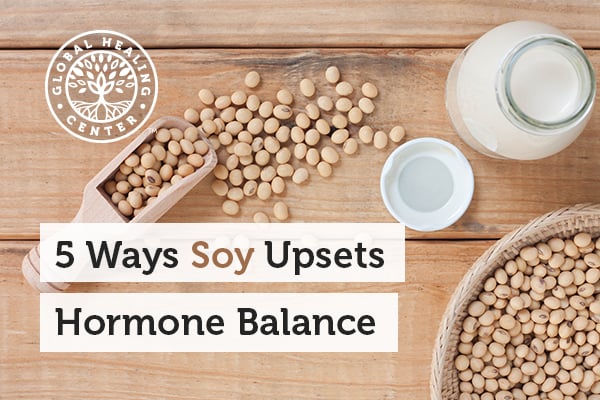5 Ways Soy Upsets Hormone Balance

Soy has been incorrectly passed off as a healthy food for a long time. Soybean oil, soy milk, and even tofu are a staple in the lives of many people, especially vegetarians. However, most soy products are not real food — most are highly processed and genetically modified. In my opinion, the marketing of soy as a health food is probably one of the greatest bamboozles of all time.
5 Ways Soy Upsets Hormone Balance
One of the issues concerning soy is its high level of phytoestrogens — compounds that mimic estrogen in the body. Soy contains two primary phytoestrogens (sometimes called xenoestrogens): genistein and daidzein. Both compounds disrupt the endocrine system in both males and females.[1] These, and all, estrogen compounds are classified as isoflavones.
Isoflavones are estrogen mimickers that increase estrogenic activity. This may be helpful at times for relieving symptoms in menopausal women.[2] However, more often than not, isoflavones block and replace naturally-produced estrogen, an action that many experts believe is cause for concern. So what happens when things get out of balance?
1. Causes Premature Menstruation
Girls are reaching their first menstruation at earlier ages, now more than ever. Fifty years ago, it was common around a girl's 13th birthday. Now girls under 10 are starting to menstruate. Studies suggest soy is a contributing factor.
2. Leads to Gynecomastia
Gynecomastia — enlargement or swelling of breasts in males — has been tied to soy consumption.[3, 4] This occurs when there's an imbalance between testosterone and estrogen.
3. Kills Libido
Introducing estrogenic foods like soy into their diet can cause men to experience a loss of sexual desire.[5] Specifically, soy is linked to hypogonadism or a reduction in the size of the testes and even erectile dysfunction. These issues can normalize after soy consumption is reduced or stopped.[5]
4. May Cause Infertility
Soy may be a factor behind male and female infertility. Specifically, soy consumption has been associated with reduced sperm count in men[6] and with altered ovarian function in women.[7]
5. Linked to Breast Cancer
There's no denying the connection between xenoestrogens and breast cancer. Considering that breast cancer cells require stimulation via estrogen, it may be a wise idea to keep your consumption of estrogen and estrogen-like compounds in check, from all sources, including soy.[8]
Soy: A Toxin in Disguise
Perhaps the biggest concern with soy is we're not fed this product in small amounts. Soy is a cheap, subsidized ingredient used in processed foods in the form of oil, thickeners, flavor enhancers, stabilizers, preservatives, and nutritive fillers. Check the ingredients; If you're eating processed food, you're probably eating soy.
Is Any Soy Good?
Fermented soy, like tempeh and natto, can be healthy since the goitrogens and nutritive inhibitors are significantly reduced. Regardless, keep in mind that most soy, even fermented, is likely to be GMO. When it comes to non-organic and unfermented soy, I've personally added it to my "avoid" list.

Watch an In-Depth Video on How to Balance Your Hormones Naturally
Length: 86 minutes
References (8)
- Barlow J , et al. Early Life Exposure to the Phytoestrogen Genistein and Breast Cancer Risk in Later Years FACT SHEET on the PHYTOESTROGEN GENISTEIN. Breast Cancer and the Environmental Research Program.
- Cheng G, et al. Isoflavone treatment for acute menopausal symptoms. Menopause. 2007 May-Jun;14(3 Pt 1):468-473.
- Valladares L, et al. Soy isoflavones and human health: breast cancer and puberty timing. Rev Med Chil. 2012 Apr;140(4):512-516.
- "Soy Infant Formula." National Institute of Environmental Health Sciences, National Institutes of Health. Updated 15 Apr 2020. Accessed 8 May 2020.
- Siepmann T, Roofeh J, Kiefer FW, Edelson DG. Hypogonadism and erectile dysfunction associated with soy product consumption. Nutrition. 2011 Jul-Aug;27(7-8):859-862.
- Chavarro JE, et al. Soy food and isoflavone intake in relation to semen quality parameters among men from an infertility clinic. Hum Reprod. 2008 Nov;23(11):2584-2590.
- Jefferson WN. Adult ovarian function can be affected by high levels of soy. J Nutr. 2010 Dec; 140(12): 2322S-2325S.
- Russo J, Russo IH. The role of estrogen in the initiation of breast cancer. J Steroid Biochem Mol Biol. 2006 Dec;102(1-5):89-96.
†Results may vary. Information and statements made are for education purposes and are not intended to replace the advice of your doctor. If you have a severe medical condition or health concern, see your physician.

Dr. Edward Group, DC
FOUNDER | HEALER | ADVOCATEDr. Group, DC is a healer and alternative health advocate, and an industry leader and innovator in the field of natural health who is dedicated to helping others. He is a registered doctor of chiropractic (DC), a naturopathic practitioner (NP), and proud alum of Harvard Business School and MIT Sloan School of Management. Dr. Group, DC is the founder of Global Healing – a mission and vision he has shared through best-selling books and frequent media appearances. He aims to spread his message of positivity, hope, and wellness throughout the world.










